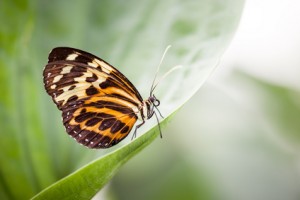 Who doesn’t love a butterfly? Most people think of aesthetic value when they consider the benefits of butterflies. But beyond their good looks, butterflies are an important link in the ecosystem. The adult insects and their larvae are critical to the food chain and provide nutrition for many birds, bats, and insect-eating animals. When butterflies start to disappear, the health of the rest of the ecosystem is drawn into question.
Who doesn’t love a butterfly? Most people think of aesthetic value when they consider the benefits of butterflies. But beyond their good looks, butterflies are an important link in the ecosystem. The adult insects and their larvae are critical to the food chain and provide nutrition for many birds, bats, and insect-eating animals. When butterflies start to disappear, the health of the rest of the ecosystem is drawn into question.
On a very small scale, your butterfly garden can help piece together their fragmented habitat.
What Can Gardeners Do to Protect Butterflies?
If you want to protect butterflies, put the sprayer down and step away from the pesticide! Most pesticides are not selective. The same chemical you use to kill the aphids on your roses can harm the beneficial insects living in your garden, including butterflies.
Once you’ve stopped spraying indiscriminately, you can create a butterfly garden.
The next step in protecting butterflies and creating a butterfly garden is to do a little research specific to your area. To find out which butterfly species are native to your region, the best source of information is your local cooperative extension service, university, or state fish and wildlife department. First, find out which butterfly species are native to your area. Then, research which plants serve as host plants for those specific species. This is a very important step as female adult butterflies are very particular about where they lay their eggs. They won’t lay their eggs just anywhere, because the larvae will need an immediate food source when they hatch.
What Can Gardeners Do to Attract Butterflies?
Butterflies Need Food
If you want to attract butterflies, you need to provide food sources for both the larval (caterpillar) and adult life-stages of the insect. As mentioned above, caterpillars need a host plant. Many host plants will be native to your region, and these should be incorporated into your butterfly garden. Be prepared to see these plants munched a little, and remind yourself that in a short time these hungry caterpillars will be beautiful butterflies.
As adults, butterflies need high-energy food in the form of sugar-rich plant nectar. Some specific butterfly garden plants are listed below, but please take the time to get region-specific information for your area.
Butterflies Enjoy Sunbathing
Provide a sunny, muddy puddle if you want to create a butterfly garden. The inclusion of a puddle may not be your idea of an aesthetically pleasing garden design. Not to worry. As a substitute, you can place a boulder with an indentation that will catch and hold water in a sunny location. You can also take the top off of a birdbath and place it on the ground in a planting bed filled with plants that attract butterflies. Most birdbaths are too deep for butterflies, so add some small pebbles and let them get gunky with algae. The butterflies will love it.
A Place for Laying Eggs
The adult female will also need plants where she can lay her eggs. These are the caterpillar host plants specific to each species that I mentioned above. Luckily, many common garden plants attract butterflies and serve as host plants.
Garden Plants That Attract Butterflies
It’s important to do your species-specific research before making a list of plants and visiting the garden center. That said, there are several garden plants that can be used in your butterfly garden. Some even provide habitat for both life stages.
Host Plants for Caterpillars:
Alcea rosea (hollyhock)
Betula spp. (birch)
Ceanothus spp. (wild lilac)
Cornus spp. (dogwood)
Escallonia spp. (escallonia)
Helianthus spp. (sunflower)
Humulus lupulus (hops)
Lavandula spp. (lavender)
Lavatera (tree mallow)
Lupinus (lupine)
Pinus spp. (pine)
Quercus spp. (oak)
Rhododendron sp. (rhododendron and azalea)
Salix sp. (willow)
Spirea spp. (spirea)
Nectar Plants for Adult Butterflies:
Achillea spp. (yarrow)
Ceanothus spp. (wild lilac)
Chrysanthemum spp. (daisy)
Cosmos bipnnatus (cosmos)
Cornus spp. (dogwood)
Helianthus spp. (sunflower)
Iberis sempervirens (candytuft)
Lupinus (lupine)
Philadelphus lewisia (mock orange)
Sambucus spp. (elderberry)
Spirea spp. (spirea)
Syringa vulgaris (lilac)
Teucrium chamaedrys (germander)
Verbena bonariensis (tall verbena)
